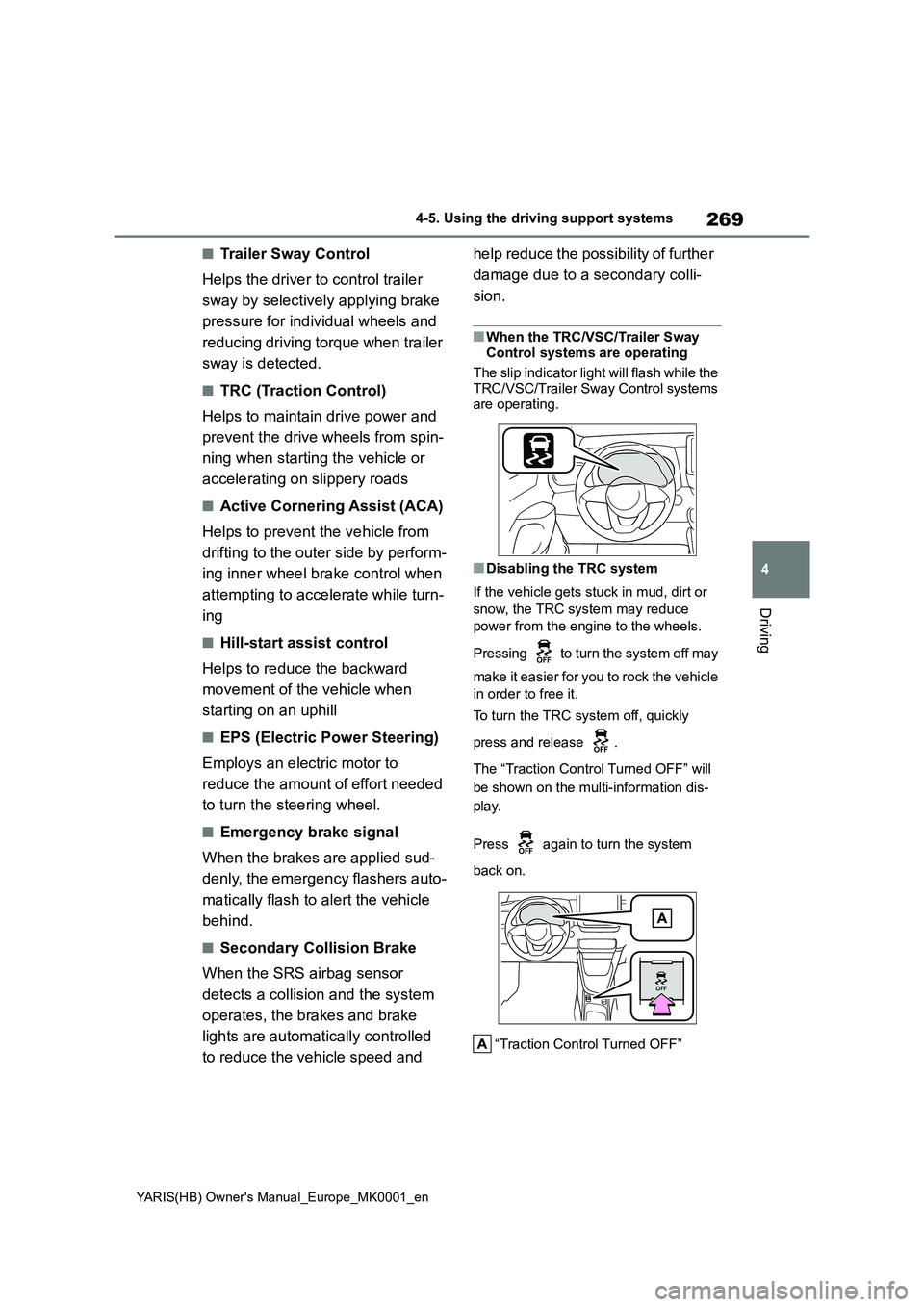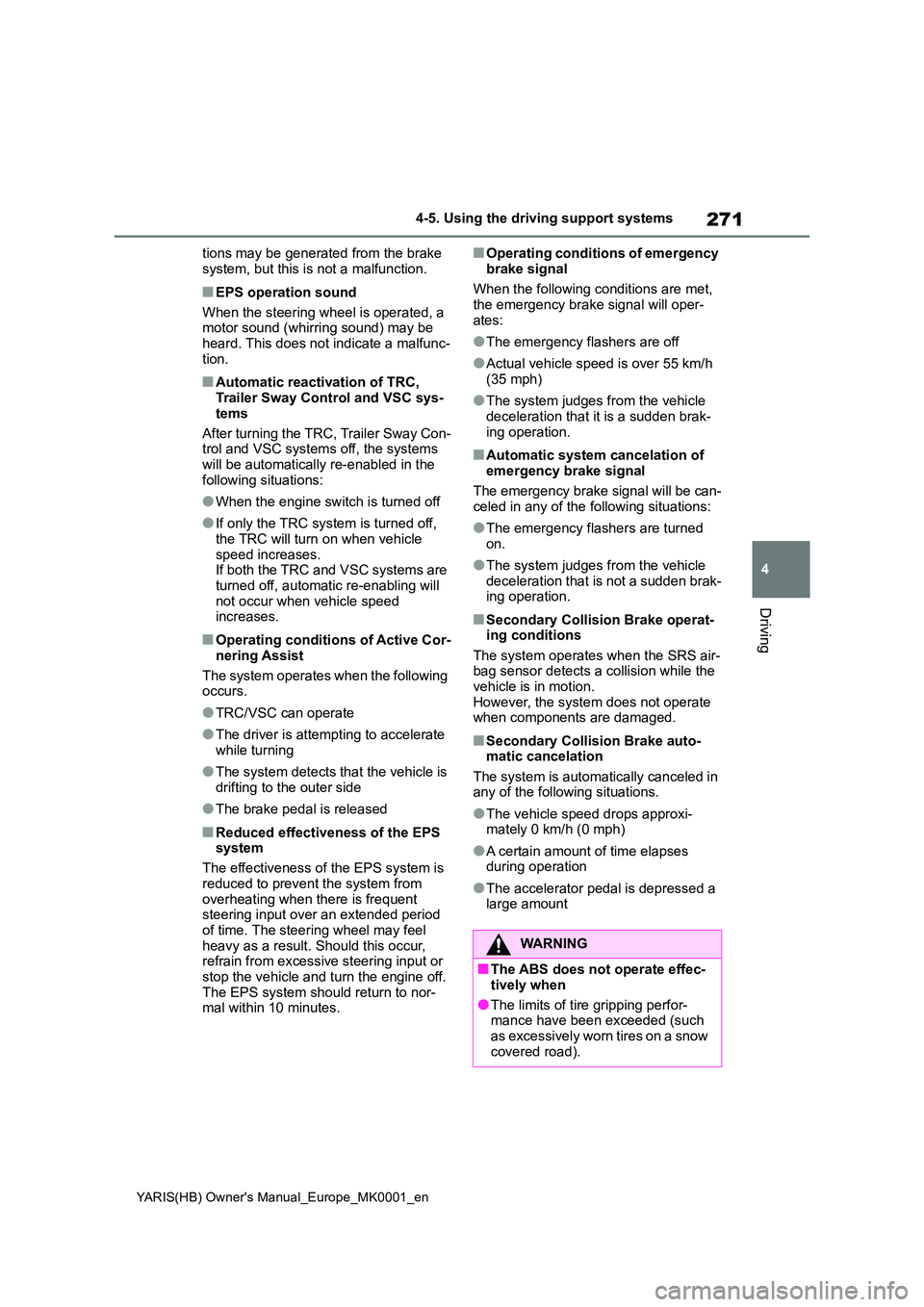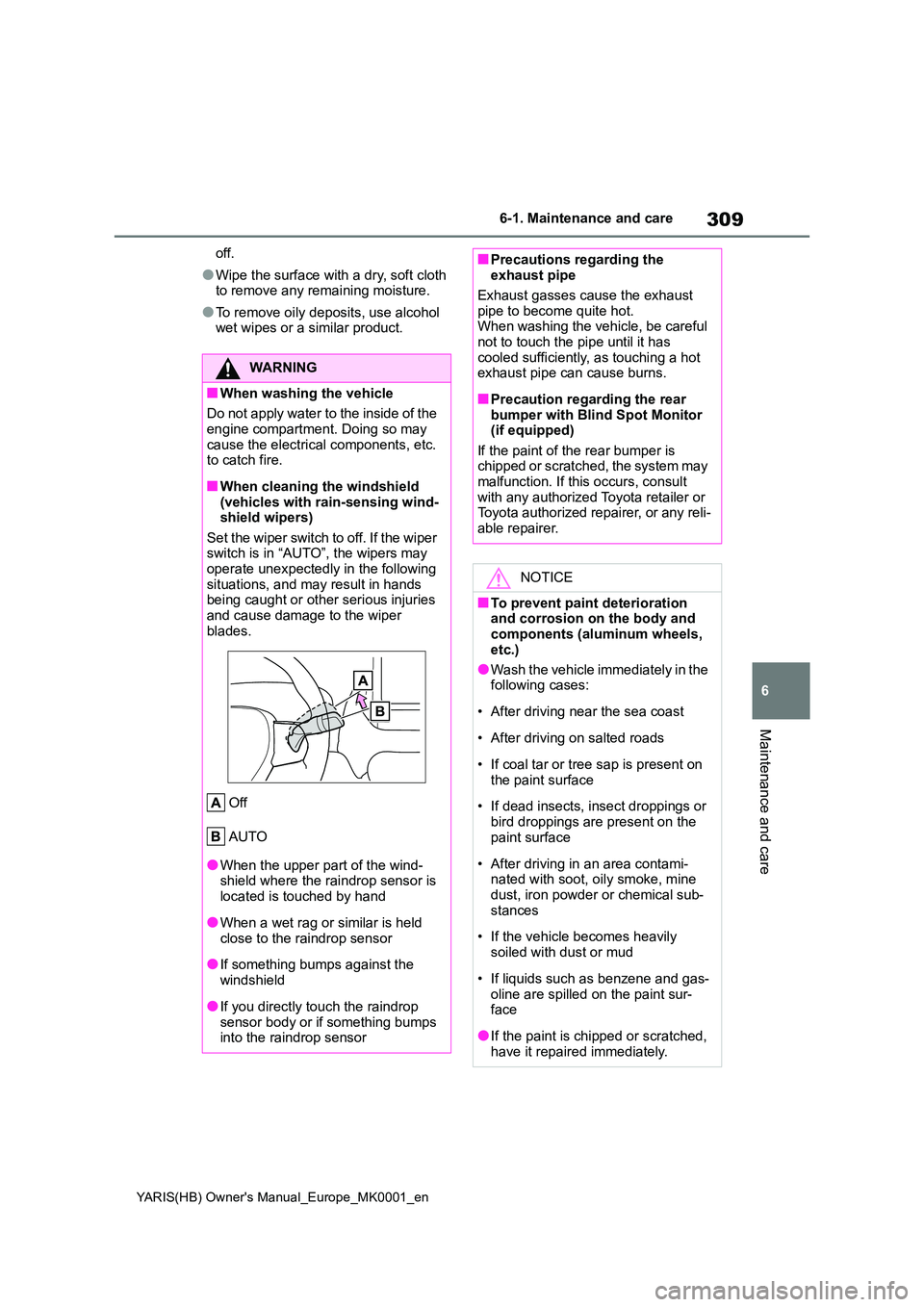2021 TOYOTA YARIS HATCHBACK sensor
[x] Cancel search: sensorPage 264 of 568

264
YARIS(HB) Owner's Manual_Europe_MK0001_en
4-5. Using the driving support systems
behind
●Vehicles backing up in a parking space next to your vehicle
●Vehicles that the sensors cannot detect due to obstructions
●Vehicles which suddenly accelerate or decelerate near your vehicle
●Guardrails, walls, signs, parked vehi-
cles and similar stationary objects*
●Small motorcycles, bicycles, pedestri-
ans, etc.*
●Vehicles moving away from your vehi-
cle
●Vehicles approaching from the park-
ing spaces next to your vehicle*
●Objects which are extremely close to
a radar sensor*
●Vehicles which are approaching from the right or left at the rear of the vehi-cle at a traveling speed of less than
approximately 8 km/h (5 mph)
●Vehicles which are approaching from
the right or left at the rear of the vehi- cle at a traveling speed of more than approximately 24 km/h (15 mph)*: Depending on the conditions, detec-
tion of a vehicle and/or object may
occur.
■RCTA buzzer
Regardless of whether the RCTA func- tion is enabled or not ( →P.248), if the Parking Support Brake function is
enabled ( →P.252) and brake control is performed, a buzzer will sound to notify the driver.
■Situations in which the system may
operate even though there is no possibility of a collision
In some situations such as the following,
the Parking Support Brake function (rear-crossing vehicles) may operate even though there is no possibility of a
collision.
●When the parking space faces a street
and vehicles are being driven on the street
●When a detected vehicle turns while approaching the vehicle
●When a vehicle passes by the side of your vehicle
●When the distance between your vehi-cle and metal objects, such as a guardrail, wall, sign, or parked vehicle,
which may reflect electrical waves toward the rear of the vehicle, is short
Page 265 of 568

265
4
YARIS(HB) Owner's Manual_Europe_MK0001_en
4-5. Using the driving support systems
Driving
●When there are spinning objects near
your vehicle such as the fans of an air conditioning unit
●When water is splashed or sprayed toward the rear bumper, such as from a sprinkler
■Situations in which the Parking
Support Brake function (rear-cross- ing vehicles) may not operate prop-erly
In some situations, such as the follow- ing, the radar sensors may not detect an object and this function may not operate
properly
●Stationary objects
●When a sensor or the area around a sensor is extremely hot or cold
●If the rear bumper is covered with ice, snow, dirt, etc.
●When it is raining heavily or water strikes the vehicle
●When the detection area of a radar sensor is obstructed by an adjacent
vehicle
●If the vehicle is significantly tilted
●When equipment that may obstruct a sensor is installed, such as a towing
eyelet, bumper protector (an addi- tional trim strip, etc.), bicycle carrier, or snow plow
●If the suspension has been modified or tires of a size other than specified
are installed
●If the front of the vehicle is raised or
lowered due to the carried load
●If an electronic component, such as a
backlit license plate (especially fluo- rescent type), fog lights, fender pole
or wireless antenna is installed near a
radar sensor
●If the orientation of a radar sensor has
been changed
●When multiple vehicles are approach-
ing with only a small gap between each vehicle
●If a vehicle is approaching the rear of your vehicle rapidly
●Situations in which the radar sensor may not detect a vehicle• When a vehicle approaches from the
right or left at the rear of the vehicle while you are turning while backing up• When turning while backing up
• When backing out of a shallow angle parking spot
• When backing up on a slope with a sharp change in grade
Page 269 of 568

269
4
YARIS(HB) Owner's Manual_Europe_MK0001_en
4-5. Using the driving support systems
Driving
■Trailer Sway Control
Helps the driver to control trailer
sway by selectively applying brake
pressure for individual wheels and
reducing driving torque when trailer
sway is detected.
■TRC (Traction Control)
Helps to maintain drive power and
prevent the drive wheels from spin-
ning when starting the vehicle or
accelerating on slippery roads
■Active Cornering Assist (ACA)
Helps to prevent the vehicle from
drifting to the outer side by perform-
ing inner wheel brake control when
attempting to accelerate while turn-
ing
■Hill-start assist control
Helps to reduce the backward
movement of the vehicle when
starting on an uphill
■EPS (Electric Power Steering)
Employs an electric motor to
reduce the amount of effort needed
to turn the steering wheel.
■Emergency brake signal
When the brakes are applied sud-
denly, the emergency flashers auto-
matically flash to alert the vehicle
behind.
■Secondary Collision Brake
When the SRS airbag sensor
detects a collision and the system
operates, the brakes and brake
lights are automatically controlled
to reduce the vehicle speed and help reduce the possibility of further
damage due to a secondary colli-
sion.
■When the TRC/VSC/Trailer Sway
Control systems are operating
The slip indicator light will flash while the
TRC/VSC/Trailer Sway Control systems
are operating.
■Disabling the TRC system
If the vehicle gets stuck in mud, dirt or
snow, the TRC system may reduce
power from the engine to the wheels.
Pressing to turn the system off may
make it easier for you to rock the vehicle
in order to free it.
To turn the TRC system off, quickly
press and release .
The “Traction Control Turned OFF” will
be shown on the multi-information dis-
play.
Press again to turn the system
back on.
“Traction Control Turned OFF”
Page 271 of 568

271
4
YARIS(HB) Owner's Manual_Europe_MK0001_en
4-5. Using the driving support systems
Driving
tions may be generated from the brake
system, but this is not a malfunction.
■EPS operation sound
When the steering wheel is operated, a motor sound (whirring sound) may be
heard. This does not indicate a malfunc- tion.
■Automatic reactivation of TRC, Trailer Sway Control and VSC sys-
tems
After turning the TRC, Trailer Sway Con- trol and VSC systems off, the systems
will be automatically re-enabled in the following situations:
●When the engine switch is turned off
●If only the TRC system is turned off,
the TRC will turn on when vehicle speed increases.If both the TRC and VSC systems are
turned off, automatic re-enabling will not occur when vehicle speed increases.
■Operating conditions of Active Cor-
nering Assist
The system operates when the following occurs.
●TRC/VSC can operate
●The driver is attempting to accelerate while turning
●The system detects that the vehicle is drifting to the outer side
●The brake pedal is released
■Reduced effectiveness of the EPS system
The effectiveness of the EPS system is
reduced to prevent the system from overheating when there is frequent steering input over an extended period
of time. The steering wheel may feel heavy as a result. Should this occur, refrain from excessive steering input or
stop the vehicle and turn the engine off. The EPS system should return to nor-mal within 10 minutes.
■Operating conditions of emergency
brake signal
When the following conditions are met, the emergency brake signal will oper-
ates:
●The emergency flashers are off
●Actual vehicle speed is over 55 km/h (35 mph)
●The system judges from the vehicle deceleration that it is a sudden brak-
ing operation.
■Automatic system cancelation of emergency brake signal
The emergency brake signal will be can-
celed in any of the following situations:
●The emergency flashers are turned
on.
●The system judges from the vehicle
deceleration that is not a sudden brak- ing operation.
■Secondary Collision Brake operat-ing conditions
The system operates when the SRS air- bag sensor detects a collision while the vehicle is in motion.
However, the system does not operate when components are damaged.
■Secondary Collision Brake auto-matic cancelation
The system is automatically canceled in any of the following situations.
●The vehicle speed drops approxi-mately 0 km/h (0 mph)
●A certain amount of time elapses during operation
●The accelerator pedal is depressed a large amount
WARNING
■The ABS does not operate effec-
tively when
●The limits of tire gripping perfor- mance have been exceeded (such
as excessively worn tires on a snow covered road).
Page 309 of 568

309
6
YARIS(HB) Owner's Manual_Europe_MK0001_en
6-1. Maintenance and care
Maintenance and care
off.
●Wipe the surface with a dry, soft cloth to remove any remaining moisture.
●To remove oily deposits, use alcohol wet wipes or a similar product.
WARNING
■When washing the vehicle
Do not apply water to the inside of the engine compartment. Doing so may
cause the electrical components, etc. to catch fire.
■When cleaning the windshield (vehicles with rain-sensing wind-shield wipers)
Set the wiper switch to off. If the wiper switch is in “AUTO”, the wipers may operate unexpectedly in the following
situations, and may result in hands being caught or other serious injuries and cause damage to the wiper
blades.
Off
AUTO
●When the upper part of the wind- shield where the raindrop sensor is
located is touched by hand
●When a wet rag or similar is held
close to the raindrop sensor
●If something bumps against the
windshield
●If you directly touch the raindrop
sensor body or if something bumps into the raindrop sensor
■Precautions regarding the exhaust pipe
Exhaust gasses cause the exhaust
pipe to become quite hot. When washing the vehicle, be careful not to touch the pipe until it has
cooled sufficiently, as touching a hot exhaust pipe can cause burns.
■Precaution regarding the rear bumper with Blind Spot Monitor (if equipped)
If the paint of the rear bumper is chipped or scratched, the system may malfunction. If this occurs, consult
with any authorized Toyota retailer or Toyota authorized repairer, or any reli-able repairer.
NOTICE
■To prevent paint deterioration and corrosion on the body and components (aluminum wheels,
etc.)
●Wash the vehicle immediately in the following cases:
• After driving near the sea coast
• After driving on salted roads
• If coal tar or tree sap is present on
the paint surface
• If dead insects, insect droppings or
bird droppings are present on the paint surface
• After driving in an area contami- nated with soot, oily smoke, mine dust, iron powder or chemical sub-
stances
• If the vehicle becomes heavily
soiled with dust or mud
• If liquids such as benzene and gas-
oline are spilled on the paint sur- face
●If the paint is chipped or scratched, have it repaired immediately.
Page 373 of 568

373
7
YARIS(HB) Owner's Manual_Europe_MK0001_en
7-2. Steps to take in an emergency
When trouble arises
■Toyota parking assist-sensor OFF indicator (warning buzzer)
■“RCTA OFF” indicator (warning buzzer)
■PKSB OFF indicator
Warning lightDetails/Actions
(Flashes)
(if equipped)
Indicates a malfunction in the Toyota parking assist-sensor func-
tion
→ Have the vehicle inspected by any authorized Toyota
retailer or Toyota authorized repairer, or any reliable
repairer immediately.
Indicates that the system is temporarily unavailable, possibly due
to a sensor being dirty or covered with ice, etc.
→ Follow the instructions displayed on the multi-information
display. ( →P.244)
Warning lightDetails/Actions
(Flashes)
(if equipped)
Indicates a malfunction in the RCTA (Rear Crossing Traffic Alert)
function
→ Have the vehicle inspected by any authorized Toyota
retailer or Toyota authorized repairer, or any reliable
repairer immediately.
Indicates that the rear bumper around the radar sensor is covered
with dirt, etc. ( →P.238)
→ Follow the instructions displayed on the multi-information
display. ( →P.248)
Warning lightDetails/Actions
(if equipped)
When a buzzer sounds:
Indicates a malfunction in the PKSB (Parking Support Brake) sys-
tem
→ Have the vehicle inspected by any authorized Toyota
retailer or Toyota authorized repairer, or any reliable
repairer immediately.
When a buzzer does not sound:
Indicates that the system is temporarily unavailable, possibly due
to a sensor being dirty or covered with ice, etc.
→ Follow the instructions displayed on the multi-information
display. ( →P.255, 377)
Page 374 of 568

374
YARIS(HB) Owner's Manual_Europe_MK0001_en
7-2. Steps to take in an emergency
■PCS warning light
■Slip indicator
■Warning buzzer
In some cases, the buzzer may not be heard due to being in a noisy location or audio sound.
■Front passenger detection sensor,
seat belt reminder and warning buzzer
●If luggage is placed on the front pas-senger seat, the front passenger detection sensor may cause the warn-
ing light to flash and the warning buzzer to sound even if a passenger is not sitting in the seat.
●If a cushion is placed on the seat, the
sensor may not detect a passenger,
and the warning light may not operate properly.
■If the malfunction indicator lamp comes on while driving
For some models, the malfunction indi- cator lamp will come on if the fuel tank becomes completely empty. If the fuel
tank is empty, refuel the vehicle immedi- ately. The malfunction indicator lamp will go off after several trips.
If the malfunction indicator lamp does not go off, contact any authorized Toyota retailer or Toyota authorized repairer, or
any reliable repairer as soon as possi-
Warning lightDetails/Actions
(Flashes or illumi- nates)
(if equipped)
When a buzzer sounds simultaneously:
Indicates a malfunction has occurred in the PCS (Pre-Collision
System).
→ Have the vehicle inspected by any authorized Toyota
retailer or Toyota authorized repairer, or any reliable
repairer immediately.
When a buzzer does not sound:
The PCS (Pre-Collision System) has become temporarily unavail-
able, corrective action may be necessary.
→ Follow the instructions displayed on the multi-information
display. ( →P.191, 377)
If the PCS (Pre-Collision System) or VSC (Vehicle Stability Con-
trol) system is disabled, the PCS warning light will illuminate.
→ P. 2 7 0
Warning lightDetails/Actions
Indicates a malfunction in:
�z The VSC system;
�z The TRC system; or
�z The hill-start assist control system
→ Have the vehicle inspected by any authorized Toyota
retailer or Toyota authorized repairer, or any reliable
repairer immediately.
Page 396 of 568

396
YARIS(HB) Owner's Manual_Europe_MK0001_en
7-2. Steps to take in an emergency
WARNING
■When using the full-size spare tire (if equipped)
●Replace the full-size spare tire with a standard tire as soon as possible.
●Avoid sudden acceleration, abrupt steering, sudden braking and shift-ing operations that cause sudden
engine braking.
■When using the compact spare
tire (if equipped)
●Remember that the compact spare tire provided is specifically
designed for use with your vehicle. Do not use your compact spare tire on another vehicle.
●Do not use more than one compact spare tires simultaneously.
●Replace the compact spare tire with a standard tire as soon as possible.
●Avoid sudden acceleration, abrupt steering, sudden braking and shift-
ing operations that cause sudden engine braking.
■When the compact spare tire (if equipped) is attached
The vehicle speed may not be cor-
rectly detected, and the following sys- tems may not operate correctly:
• ABS & Brake assist
• VSC
•TRC
• Automatic High Beam (if equipped)
• Cruise control (if equipped)
• Dynamic radar cruise control (if equipped)
• EPS
• Trailer Sway Control (if equipped)
• PCS (Pre-Collision System) (if
equipped)
• LTA (Lane Tracing Assist) (if equipped)
• Tire pressure warning system
• Toyota parking assist-sensor (if
equipped)
• PKSB (Parking Support Brake) (if
equipped)
• BSM (Blind Spot Monitor) (if
equipped)
• Rear view monitor system (if
equipped)
• S-IPA (Simple Intelligent Parking
Assist System) (if equipped)
• Navigation system (if equipped)
■Speed limit when using the com- pact spare tire (if equipped)
Do not drive at speeds in excess of 80 km/h (50 mph) when a compact spare tire is installed on the vehicle.
The compact spare tire is not designed for driving at high speeds.
Failure to observe this precaution may lead to an accident causing death or serious injury.
■After using the tools and jack
Before driving, make sure all the tools
and jack are securely in place in their storage location to reduce the possi-bility of personal injury during a colli-
sion or sudden braking.
NOTICE
■Be careful when driving over bumps with the compact spare
tire (if equipped) installed on the vehicle.
The vehicle becomes lower when
driving with the compact spare tire compared to when driving with stan-dard tires. Be careful when driving
over uneven road surfaces.